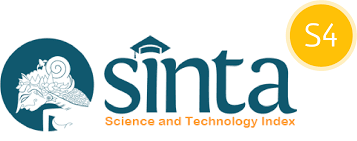Pengembangan Aplikasi Buku Penghubung Berbasis Web Sebagai Media Interaksi Sekolah – Orang Tua
DOI:
https://doi.org/10.29408/jit.v5i1.4742Keywords:
comunication book, user characteristic, diffusion of innovation theoryAbstract
Communication book is one of supporting instrument of communication mechanism of teacher and parents considered not yet effective. Thus, it is necessary to develop a communication book in the digital environment as a solution to the problem. This study aims to develop communication book applications as a medium of communication between teachers and parents. This research uses research and development (R & D) method with waterfall model approach that focused on efforts to produce a prototype of the product. Stages of research and development include communication, planning, modeling, construction, and deployment. Web-based development product using MVC design pattern concept with YII framework through the testing unit and ISO25010 standard quality. The result of this research and development is a prototype of communication book application as a proof of concept towards the approach used.
References
L. Emerson, J. Fear, S. Fox, and E. Sanders, “Parental Engagement in Learning and Schooling: Lessons from Research a Report by the Australian Alliance for Children and Youth (ARACY) for the Family-School and Community Partnership Bureau.,” Canberra, 2012.
K. V. Hoover‐Dempsey et al., “Why Do Parents Become Involved? Research Findings and Implications,” The Elementary School Journal, vol. 106, no. 2, pp. 105–130, Nov. 2005, doi: 10.1086/499194.
J. L. Epstein and F. L. van Voorhis, “More Than Minutes: Teachers’ Roles in Designing Homework,” Educational Psychologist, vol. 36, no. 3, pp. 181–193, Sep. 2001, doi: 10.1207/S15326985EP3603_4.
Bujang Rahman, “Kemitraan Orang Tua dengan Sekolah dan Pengaruhnya Terhadap Hasil Belajar Siswa,” Jurnal Pendidikan Progresif, vol. 4, no. 2, pp. 129–138, 2014.
N. Aedi and E. Rosalin, “Kerjasama Sekolah dan Masyarakat. Dalam T. D. UPI, Manajemen Pendidikan,” in Manajemen Pendidikan, Bandung: Alfabeta, 2014, p. 280.
H. Saragih, G. Gusvita, B. Reza, D. Setiyadi, and R. Akbar, “PENGEMBANGAN SISTEM INFORMASI DISTRIBUSI INFORMASI SEKOLAH MELALUI SMS GATEWAY DENGAN ZACHMAN FRAMEWORK,” Jurnal Sistem Informasi, vol. 8, no. 1, p. 32, Oct. 2013, doi: 10.21609/jsi.v8i1.320.
A. Silva, Á. Rocha, and M. P. Cota, “Electronic Booklet,” International Journal of Information and Communication Technology Education, vol. 11, no. 4, pp. 97–108, Oct. 2015, doi: 10.4018/IJICTE.2015100107.
E. M. Rogerd, Diffusion of Innovation, 5th ed. New York: Free Press, 2003.
M. S. Raisinghani and A. Ramsaroop, “Information Systems Innovation: Diffusion and Implementation Issues,” The Journal of Information Technology Theory and Application, vol. 1, p. 6, 1999.
D. Heath, R. Maghrabi, and N. K. Carr, “Implications of Information and Communication Technologies (ICT) for School-Home Communication,” Journal of Information Technology Education: Research, vol. 14, pp. 363–395, 2015, doi: 10.28945/2285.
Amirul Azuani Romle and D. Singh, “Integrated parent information system (SMIB) to increase parental involvement in children’s learning process in Malaysian primary school,” in Proceedings of the 2011 International Conference on Electrical Engineering and Informatics, Jul. 2011, pp. 1–6. doi: 10.1109/ICEEI.2011.6021593.
N. Mia, “Child’s Communication Book - ConnectABILITY,” http://connectability.ca/Garage/wp-content/themes/connectability/plugin/workshops/offToSchool/off_to_school/skills/communicate/pdf/CommunicationBook.pdf, 2010.
S. Graham-Clay, “Communicating with Parents: Strategies for Teachers.,” The School Community Journal, vol. 15, no. 1, pp. 117–129, 2005.
M. Medina and J. Kenley, “Communication Between Family and School: Creating a Communication Notebook that Works,” http://www.tsbvi.edu/outreach/2674-communication-between-family-and-school-creating-a-communication-notebook-that-works, Aug. 25, 2017.
S. Sancoko, “Tinjauan kualitas informasi sistem pembelajaran e-learning scele.ui.ac.id (studi kasus: mahasiswa bidang administrasi program vokasi UI),” Jurnal Pendidikan Vokasi, vol. 7, no. 1, p. 87, Feb. 2017, doi: 10.21831/jpv.v7i1.11928.
S. Suhartini, M. Sadali, and Y. Kuspandi Putra, “Sistem Informasi Berbasis Web Sma Al- Mukhtariyah Mamben Lauk Berbasis Php Dan Mysql Dengan Framework Codeigniter,” Infotek : Jurnal Informatika dan Teknologi, vol. 3, no. 1, pp. 79–83, Feb. 2020, doi: 10.29408/jit.v3i1.1793.
V. V. Parkar, P. Shinde, S. C. Gadade, and P. M. Shinde, “Utilization of Laravel Framework for Development of Web Based Recruitment Tool,” 2017.
R. Wardani, N. Y. Laksana, and I. B. Sutedja, “Pengembangan Media Pembelajaran Interaktif Wayang Berbasis Web untuk Pendidikan Kejuruan,” in The 14th Seminar on Intelligent Technology And Its Application, 2013, pp. 244–250.
J. W. Dearing, “Applying Diffusion of Innovation Theory to Intervention Development,” Research on Social Work Practice, vol. 19, no. 5, pp. 503–518, Sep. 2009, doi: 10.1177/1049731509335569.
J. W. DEARING, “Improving the State of Health Programming by Using Diffusion Theory,” Journal of Health Communication, vol. 9, no. sup1, pp. 21–36, Jan. 2004, doi: 10.1080/10810730490271502.
T. M. Somers, K. Nelson, and J. Karimi, “Confirmatory Factor Analysis of the End-User Computing Satisfaction Instrument: Replication within an ERP Domain*,” Decision Sciences, vol. 34, no. 3, pp. 595–621, Aug. 2003, doi: 10.1111/j.1540-5414.2003.02428.x.
B. Adams, E. S. Berner, and J. R. Wyatt, “Applying Strategies to Overcome User Resistance in a Group of Clinical Managers to a Business Software Application,” Journal of Organizational and End User Computing, vol. 16, no. 4, pp. 55–64, Oct. 2004, doi: 10.4018/joeuc.2004100104.
N. S. Sukmadinta, Metode Penelitian Pendidikan. Bandung: Remaja Rosdakarya, 2005.
R. S. Pressman, Software Engineering A Practioner’s Approach. New York: McGraw-Hill, 2010.
S. Arikunto, Dasar - Dasar Evaluasi Pendidikan, Edisi Revisi, Cetakan kesebelas. Jakarta: Bumi Aksara, 2011.
J. Akbar and A. Yaqin, “Sistem Informasi Rekam Medis Berbasis Web Pada Klinik Risa Rafana Menggunakan Metodologi Extreme Programming,” Infotek : Jurnal Informatika dan Teknologi, vol. 4, no. 2, pp. 270–279, Jul. 2021, doi: 10.29408/jit.v4i2.3680.
J. R. Lewis, “IBM computer usability satisfaction questionnaires: Psychometric evaluation and instructions for use,” International Journal of Human-Computer Interaction, vol. 7, no. 1, pp. 57–78, Jan. 1995, doi: 10.1080/10447319509526110
Downloads
Published
How to Cite
Issue
Section
License
Semua tulisan pada jurnal ini menjadi tanggung jawab penuh penulis. Jurnal Infotek memberikan akses terbuka terhadap siapapun agar informasi dan temuan pada artikel tersebut bermanfaat bagi semua orang. Jurnal Infotek ini dapat diakses dan diunduh secara gratis, tanpa dipungut biaya sesuai dengan lisense creative commons yang digunakan.
Jurnal Infotek is licensed under a Creative Commons Attribution 4.0 International License.
Statistik Pengunjung




